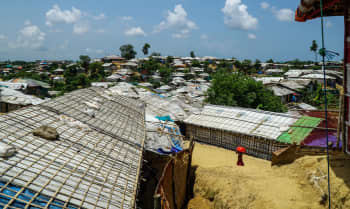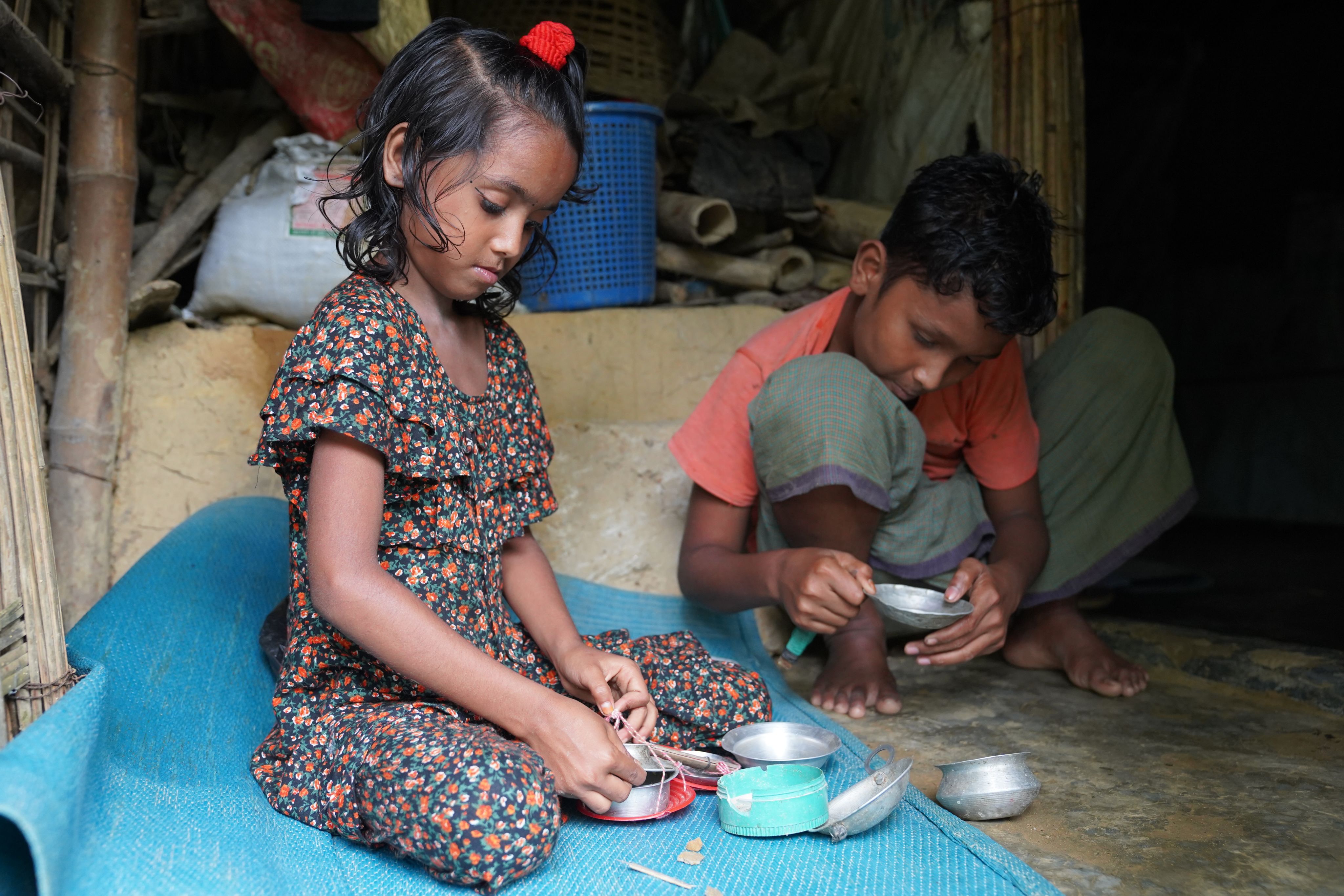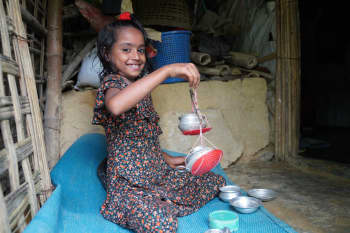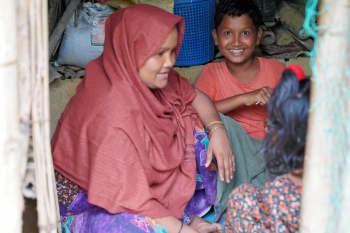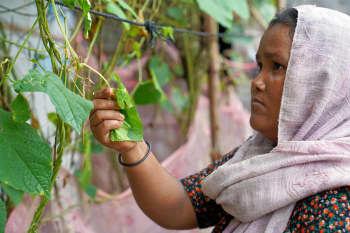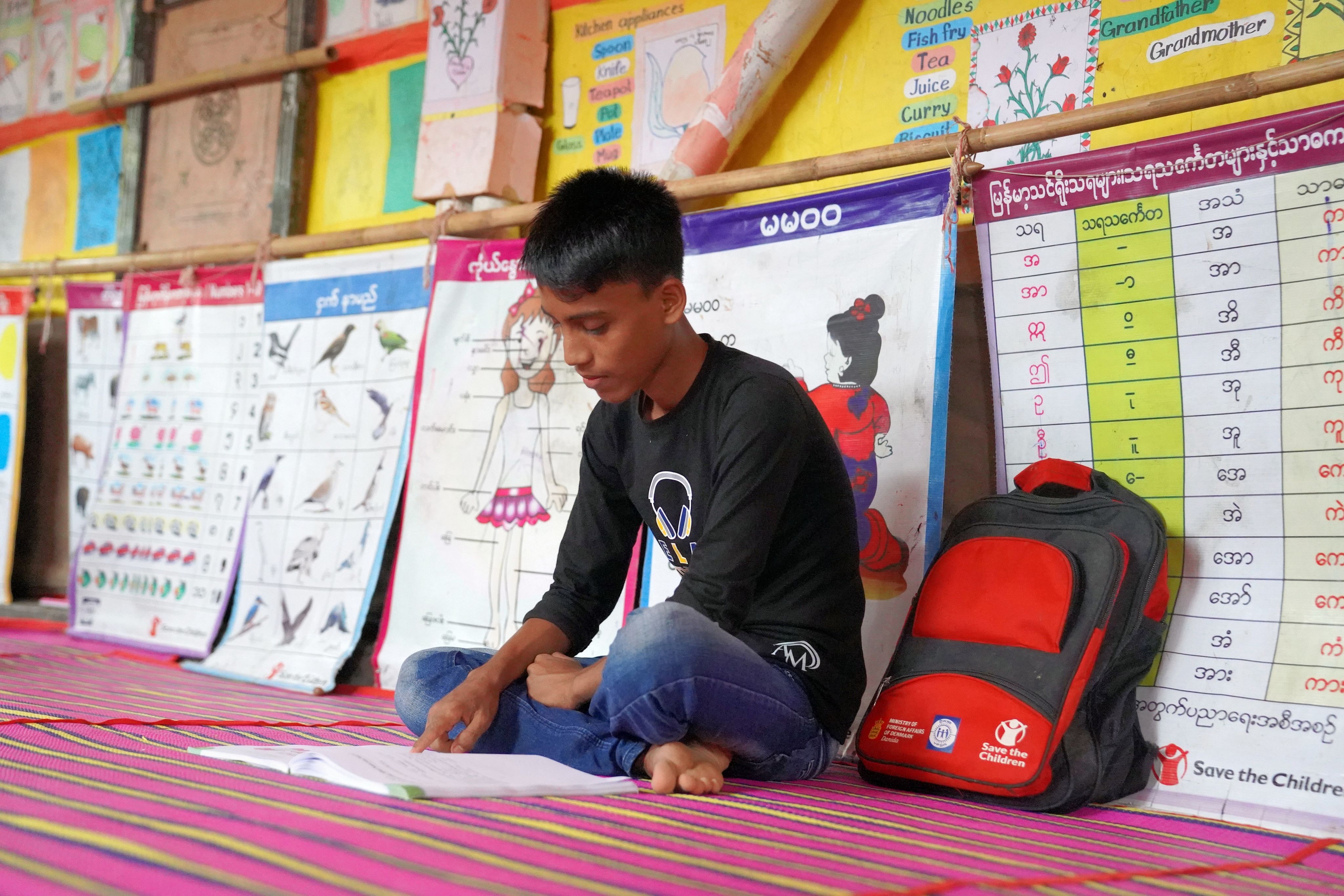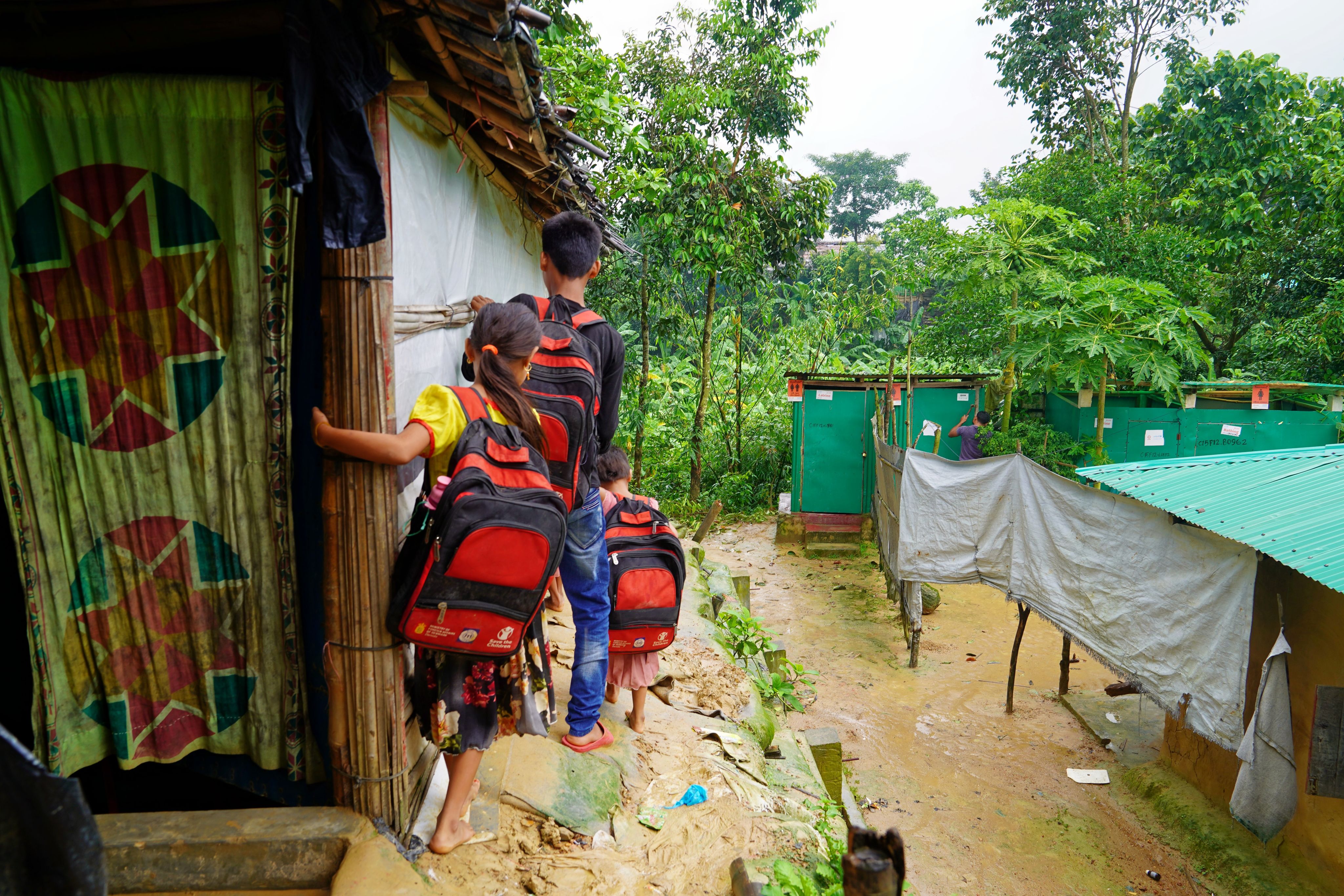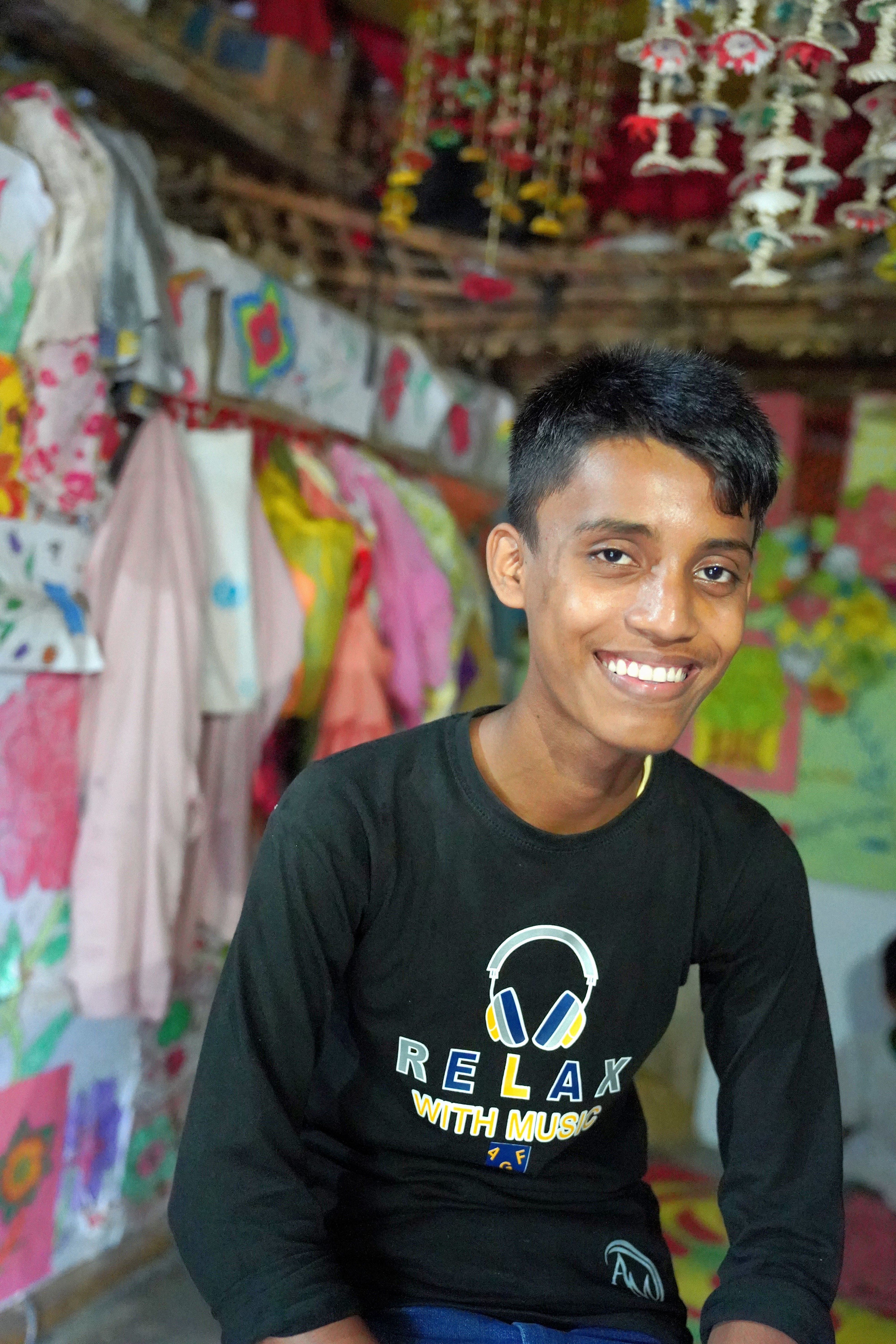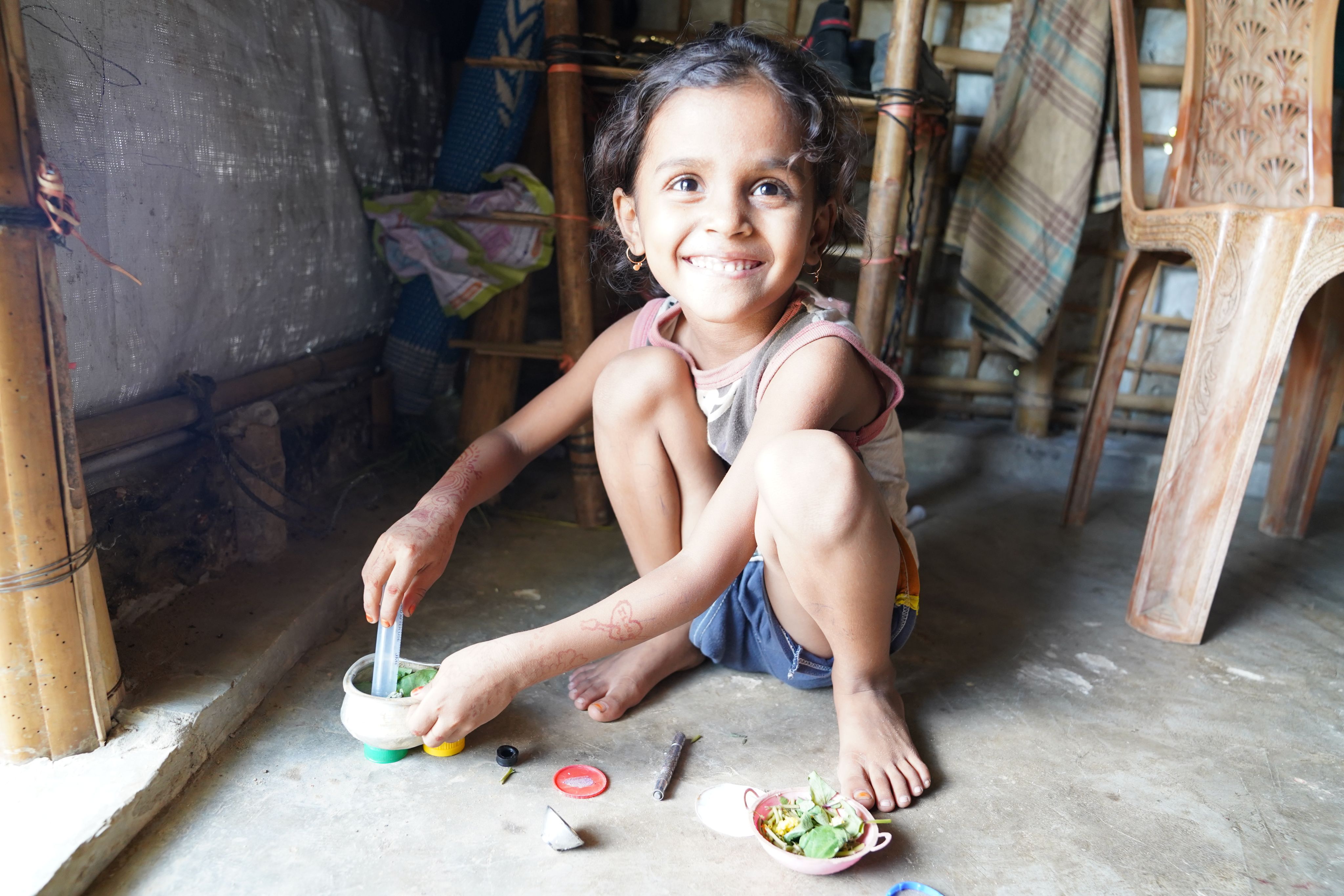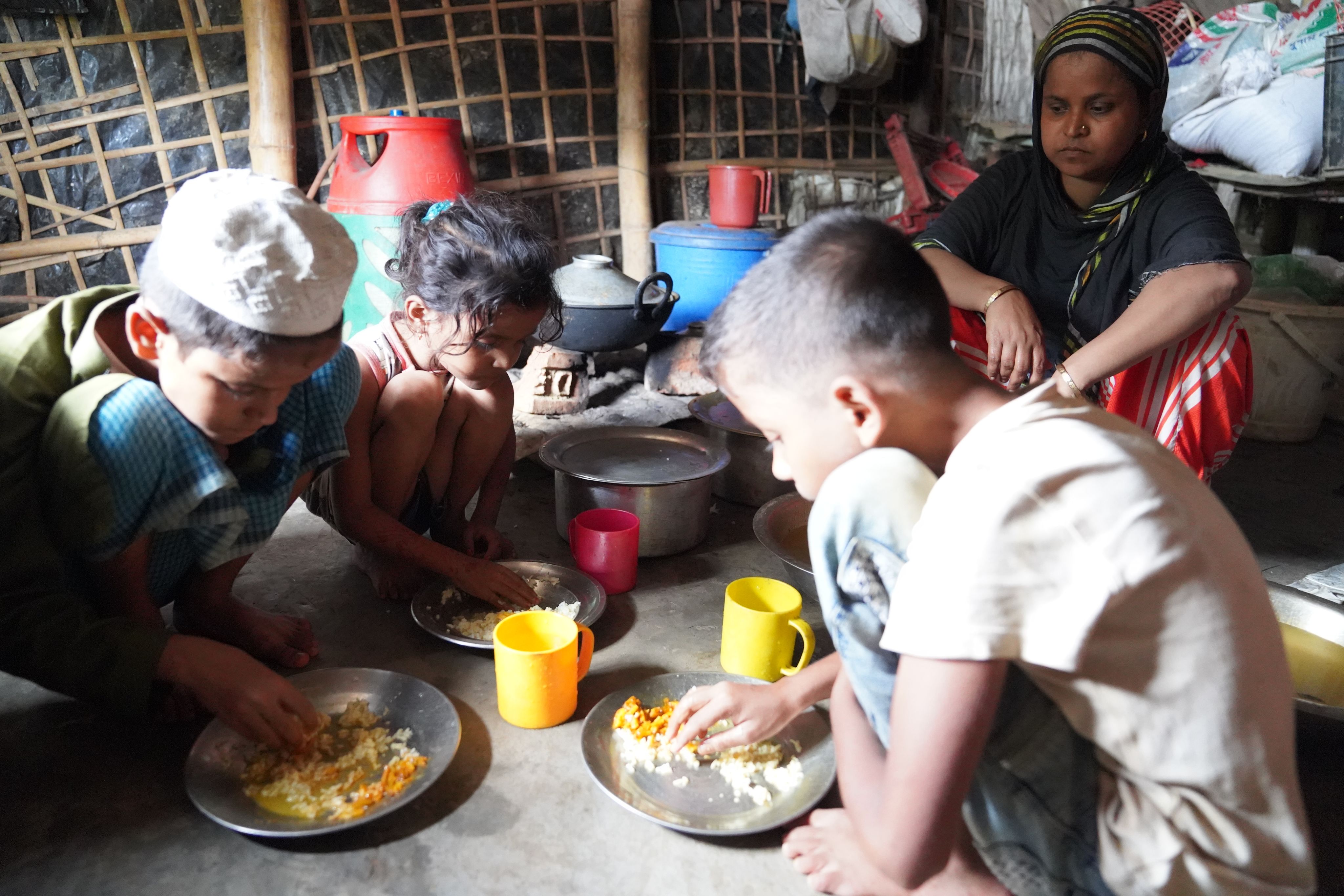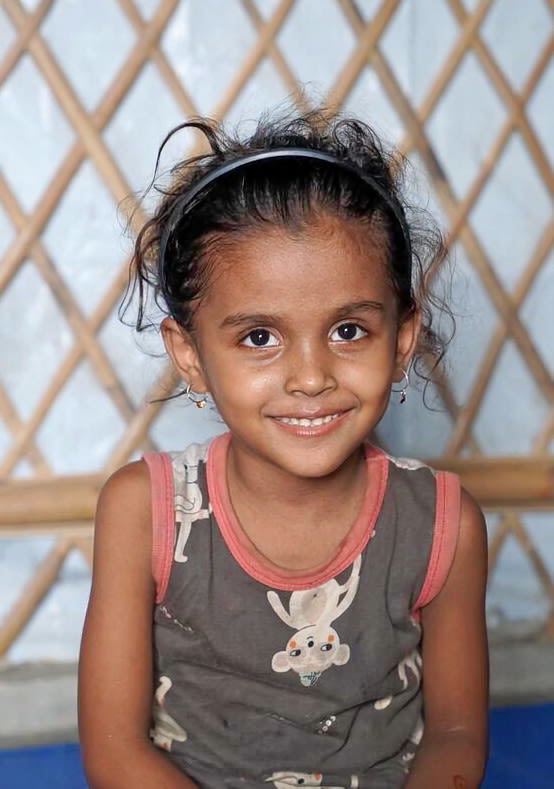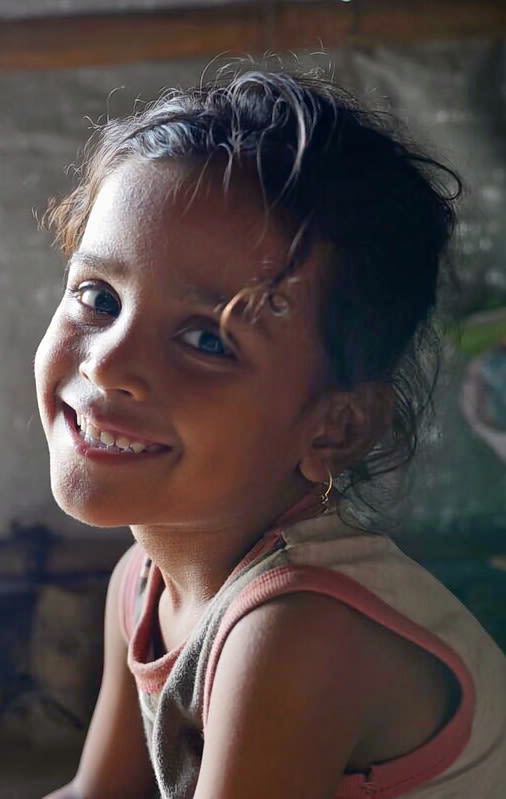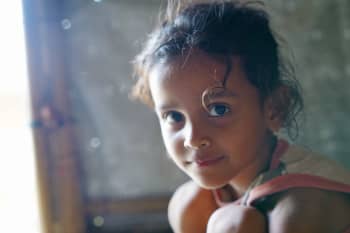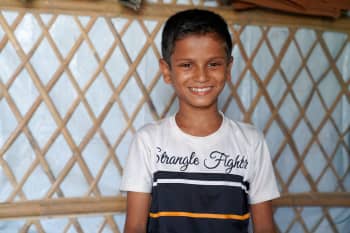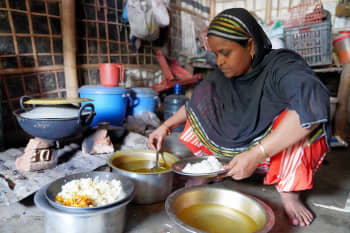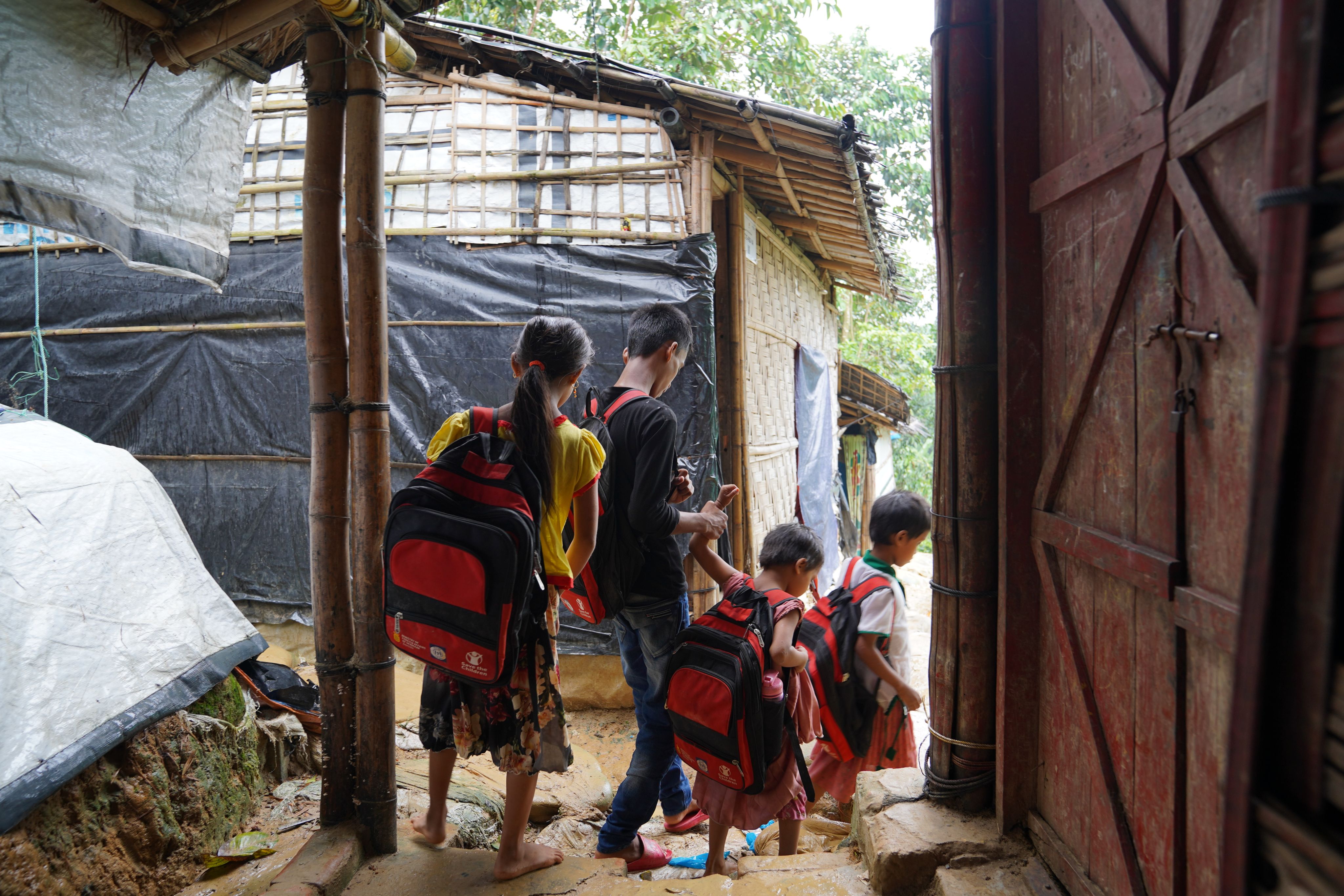The High Cost of Hunger:
A Visual Chronicle of the
Rohingya's Struggle
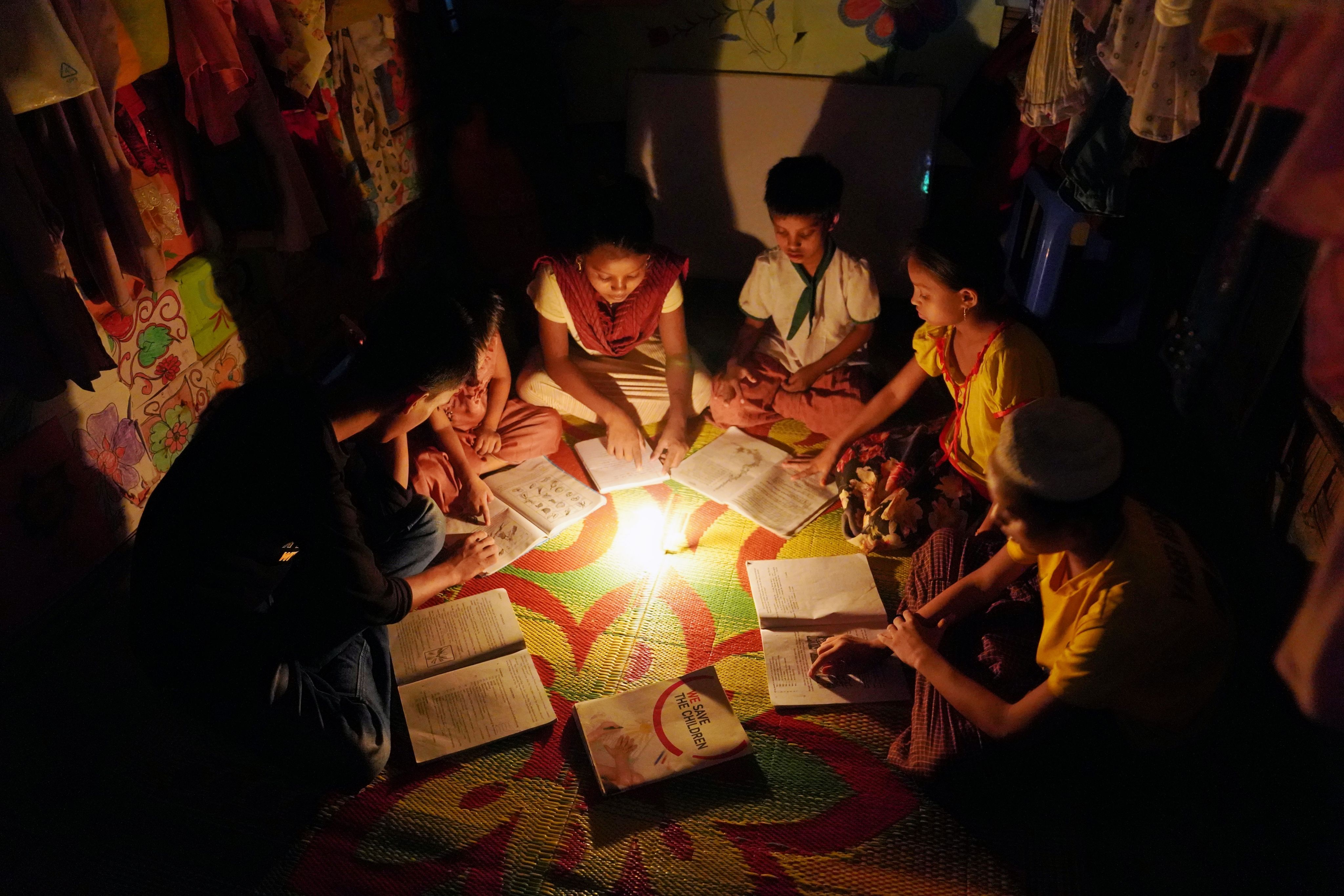
In the world’s largest refugee camp in Cox’s Bazar, Bangladesh, over 700,000 Rohingya languish in limbo, largely forgotten by the outside world six years after the crisis.
August 25, 2023, marks six years since more than 700,000 Rohingya fled violence in Myanmar to seek safety in Bangladesh. In Cox’s Bazar, Bangladesh, the humanitarian response has saved lives and provided protection and basic services for Rohingya refugees. However, six years on, conditions are getting worse for the almost 500,000 Rohingya children who remain in protracted displacement.
The humanitarian situation is reaching a breaking point. For six years, Rohingya children have gone without formal education, parents and caregivers have gone without employment, and all refugees have become more vulnerable to deaths and injuries from large-scale fires, flooding, and rising violence and insecurity in the camps than ever before.
The authorities in Bangladesh have also made clear that hosting Rohingya refugees has become a burden for them and expressed their desire for Rohingya to go back to Myanmar as soon as possible, where Rohingya are still denied citizenship and their most basic rights.
Rohingya children are worried about their futures; they need hope. Now is the time to show them that the international community has not turned its back on them.
Continue scrolling or click the menu along the top to read the stories of Rohingya children and families, and how Save the Children has been able to help.
Note: All text written in italics are direct quotes.
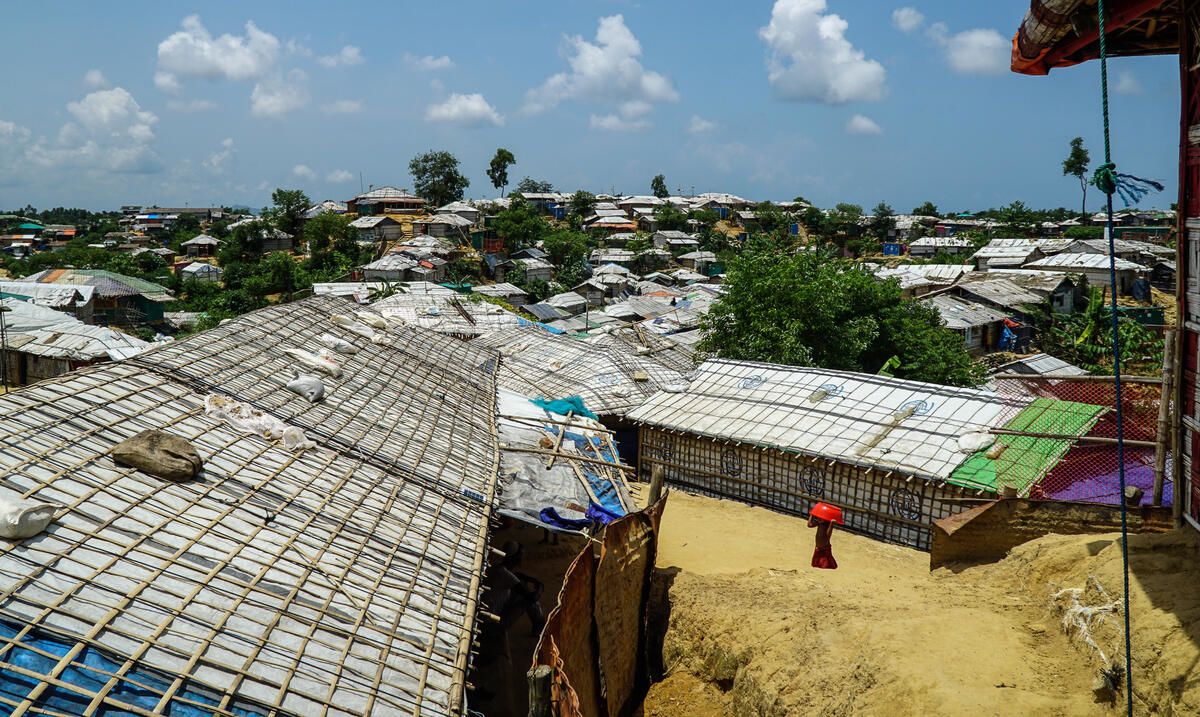
Sultana*, Mahbuba*, and Rakib*'s Stories
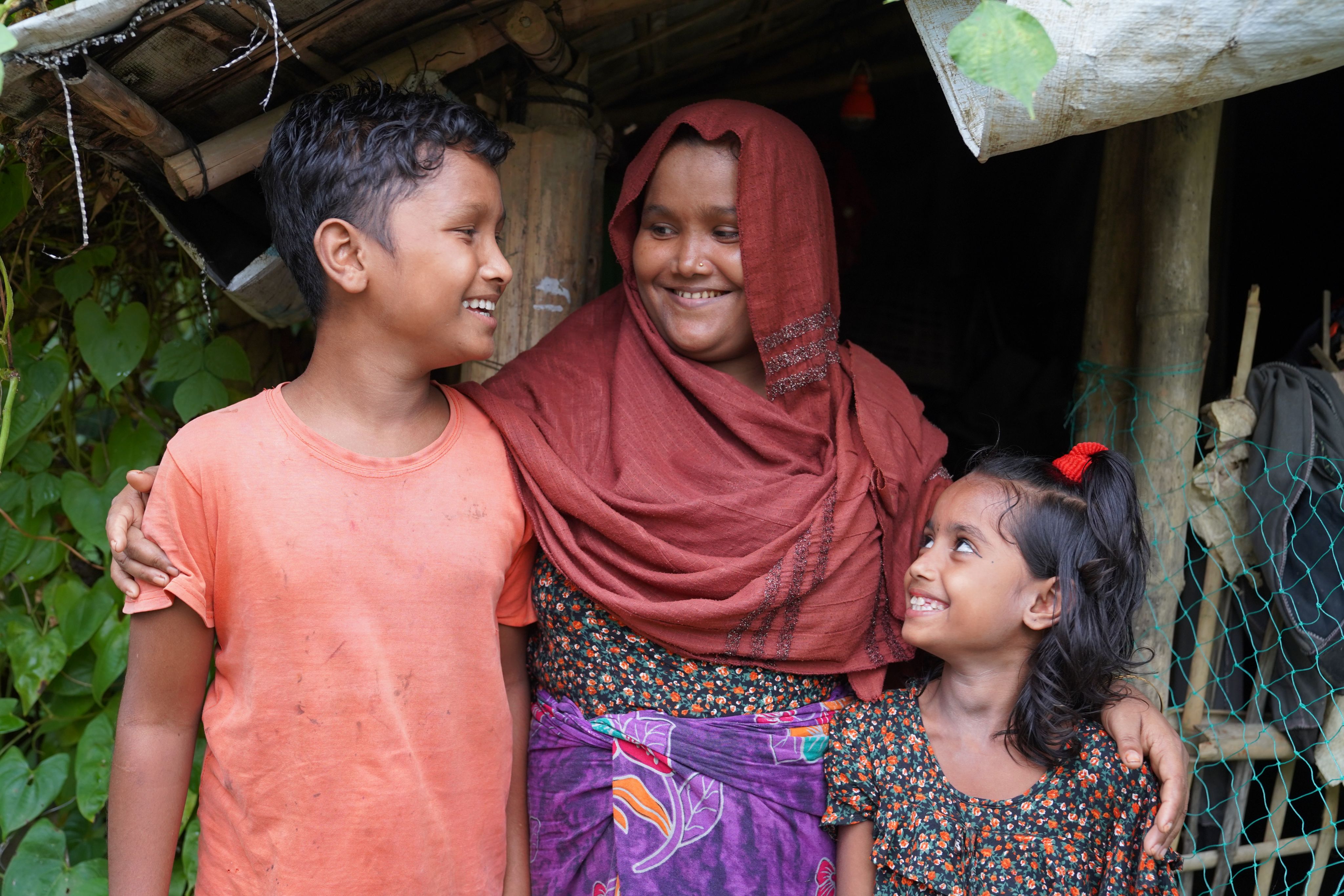
Sultana* is a seven-year-old girl and Rakib* is a 12-year-old boy. The siblings live with their 31-year-old mother, Mahbuba*, in one of the largest refugee camps in the world – Cox’s Bazar. In 2017, their father was killed during the unrest in Myanmar and, soon after, the children and their mother fled to Bangladesh in search of a safe place to live. The family used to live on land where vegetables were harvested easily. Now, as the sole provider for the family, their mother struggles to find enough food in the refugee camp for her children to eat.
This year, there have been food ration cuts two times already – from $12.00 USD to $10.00 USD and from $10.00 USD to $8.00 USD. These USD amounts are per person per month. The family used to be able to pay for fresh fish, however, they struggle to afford lentils nowadays. As a result, Mahbuba* prepares rice and salt for dinner most days and, often, she skips meals to ensure that Sultana* and Rakib* don’t go to bed hungry.
Sultana*, 7, and Rakib*, 12, play with small spice containers in their family's kitchen in Cox's Bazar, Bangladesh. Photo: Rubina Hoque Alee / Save the Children
Sultana*, 7, and Rakib*, 12, play with small spice containers in their family's kitchen in Cox's Bazar, Bangladesh. Photo: Rubina Hoque Alee / Save the Children
There are whispers of another food ration cut approaching – from $8.00 USD to $6.00 USD – and Mahbuba* worries that her family will be even more hungry in the future.
Looking forward, Mahbuba* hopes that Sultana* and Rakib* will grow up to be healthy. Meanwhile, Rakib* dreams of going abroad one day. He wants to provide for his family by building them a house.
Here, Rakib* and Mahbuba* share their story in their own words.
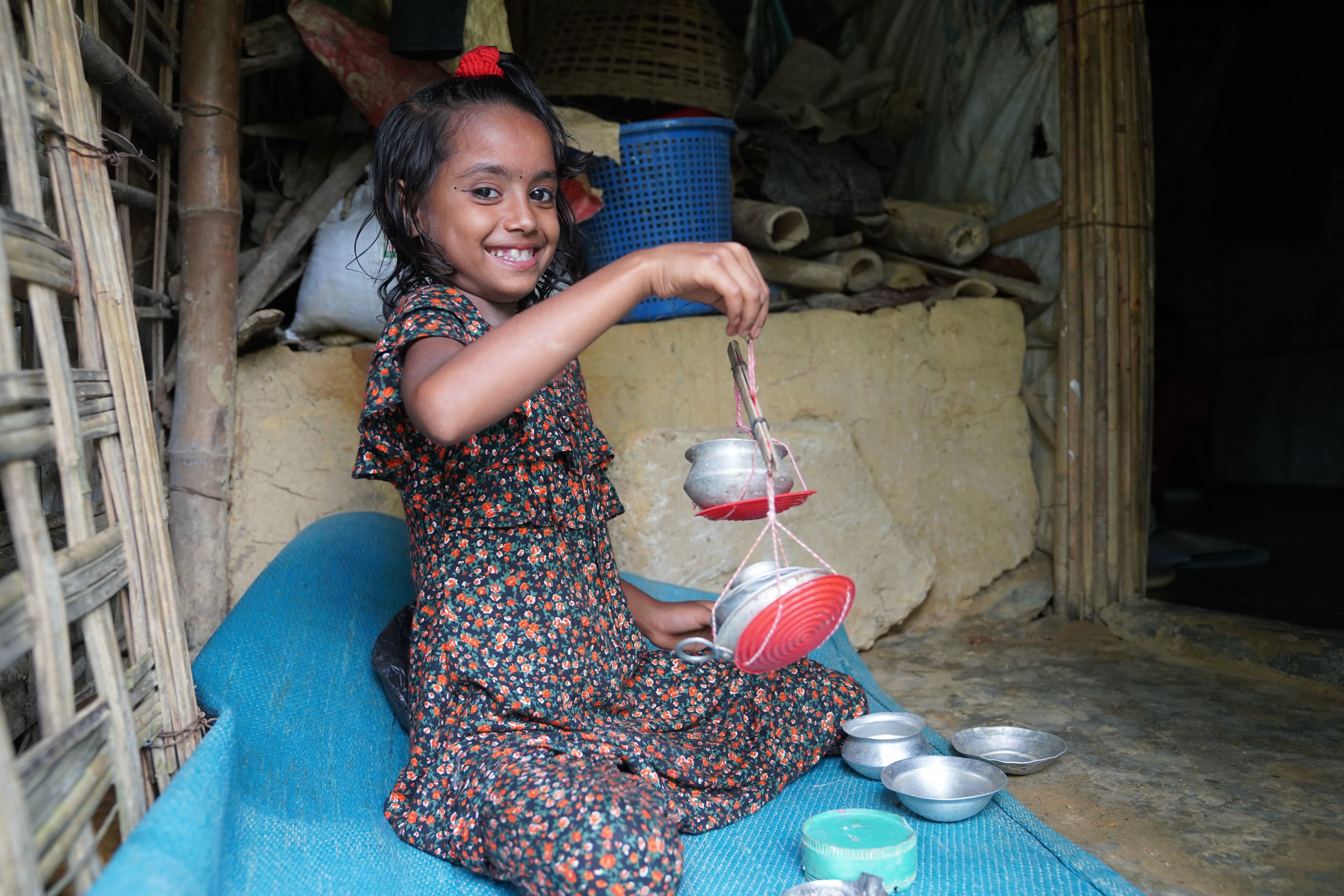
Rakib*, 12
We used to eat fresh fish in our meals before [the food cut]. Now, we can’t even buy enough lentils. Sometimes, I feel angry and sad when I see just only rice for a meal.
My father was shot dead [in Myanmar]. We left our home with that fear and came to Bangladesh.
There’s no place to play and have fun. Boys in the villages [in the host community] can travel anywhere, but we can’t go to pay visits outside the [refugee] camps because it’s not our country. If it was my country, I could roam free.
Moreover, we can’t live peacefully due to monsoon storms. As soon as the rain comes, our house becomes dripping wet. At night, we have to wake up to keep our things dry.
My dream is to go abroad one day and to build a home for us. Maybe we’ll have a beautiful life there.
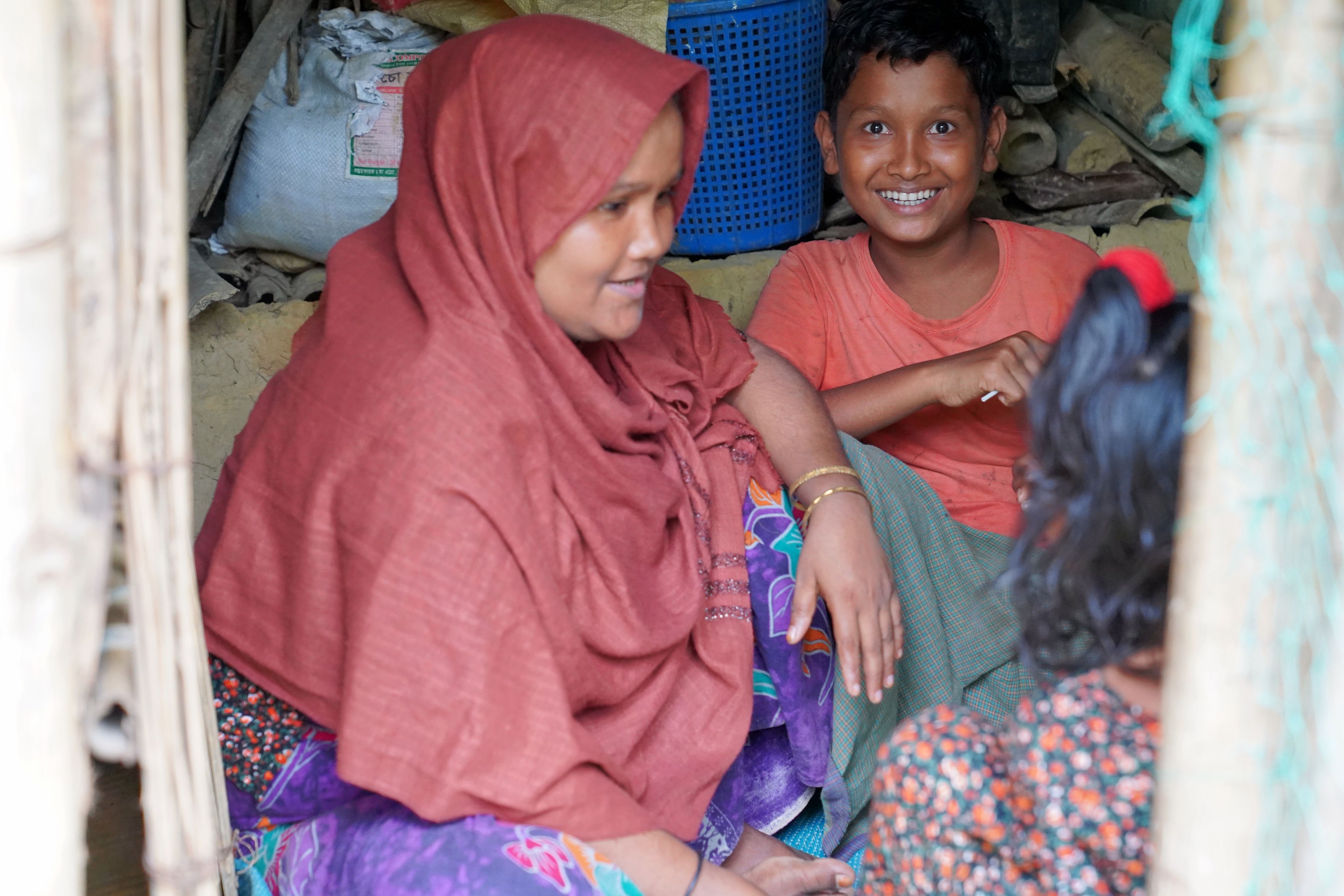
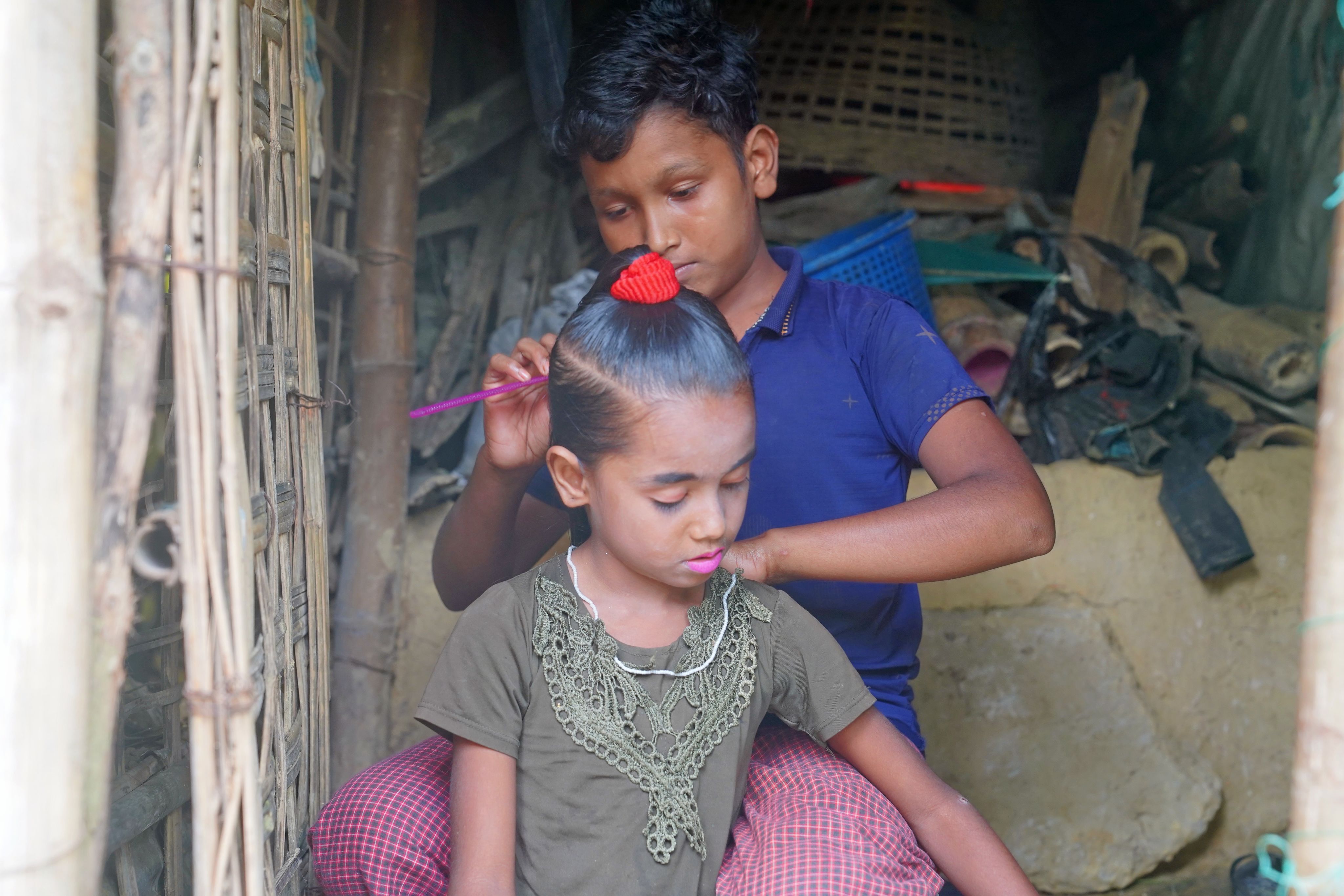
Mahbuba*, 31
We’re hearing rumours that this will be cut down to $6.00 USD soon. If that happens, then we’ll have no choice except to starve to death. When I go to collect rice from the food assistance outlets, I feel like crying at having such a tiny amount.
I’m a grown-up person, [so] I can tolerate hunger somehow. I’ve seen even worse, but how will [my] children cope?
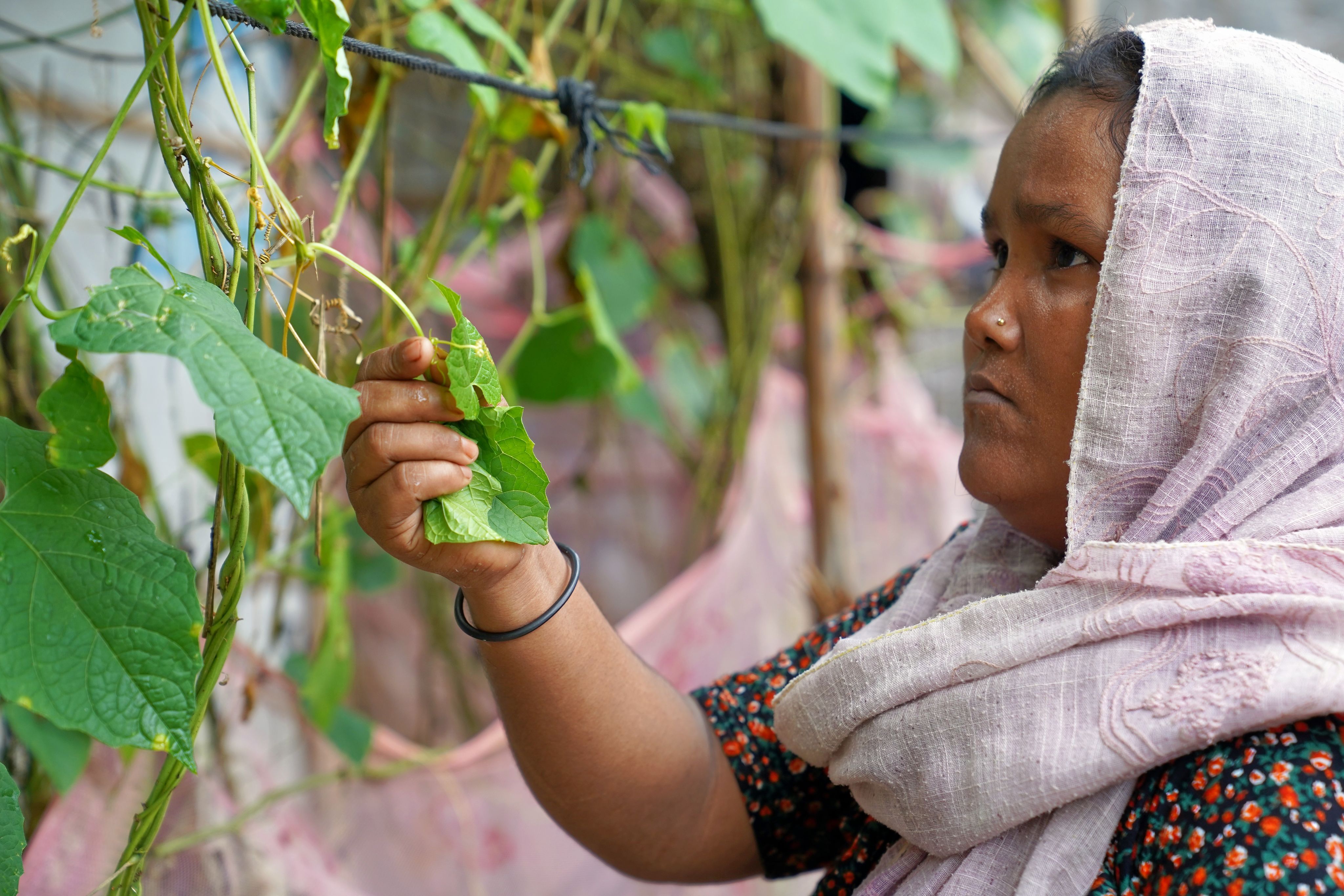
Ayaz*'s Story
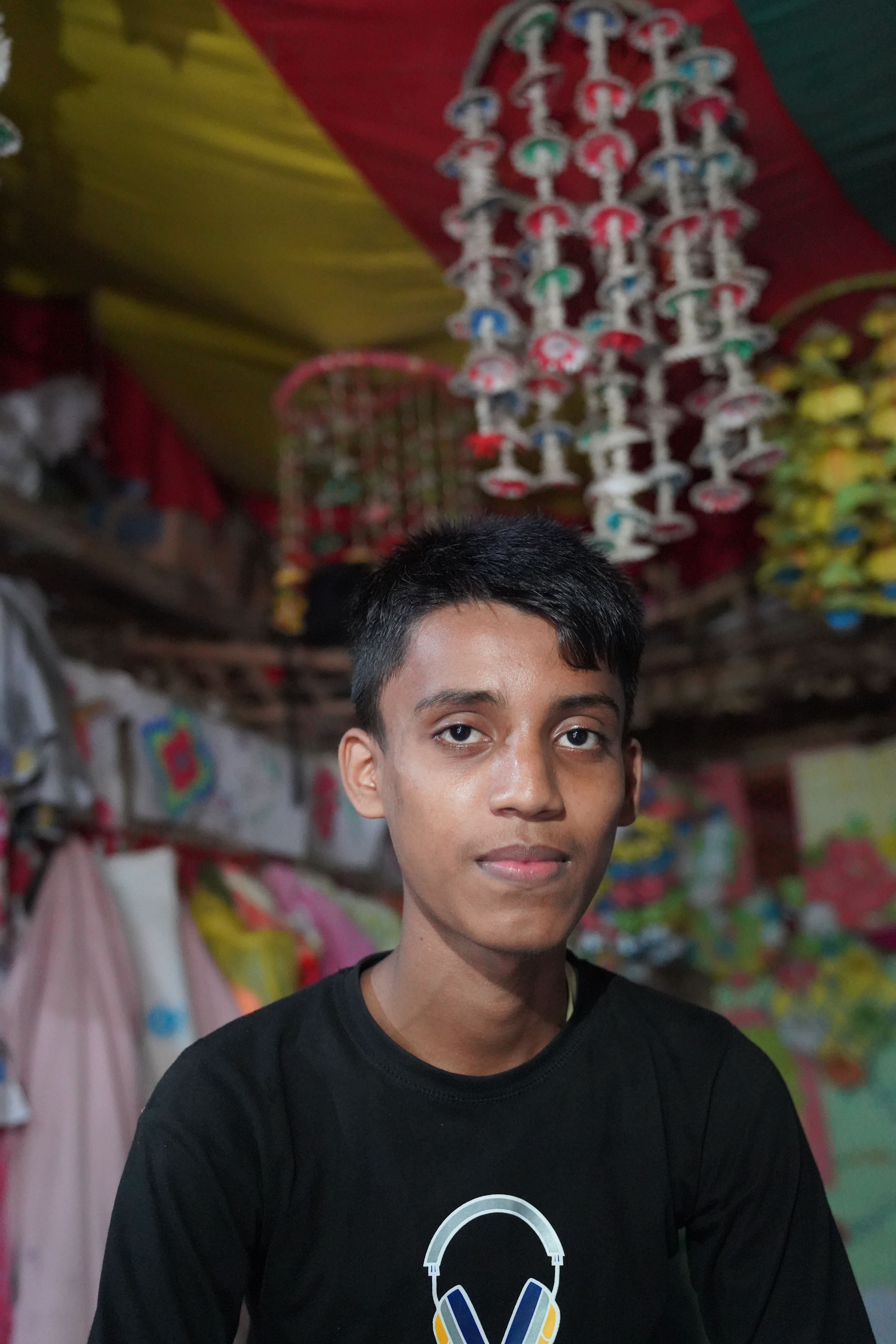
Ayaz* is a 15-year-old teenager living in a cramped, single room house in one of the largest refugee camps in the world – Cox’s Bazar – in Bangladesh. He lives with his mother as well as his five younger siblings. His father passed away six years ago and, as a result, his mother became the sole provider of the family.
Over the past five months, Ayaz* and his family have had multiple reductions in their food rations – first from $12.00 USD to $10.00 USD and second from $10.00 USD to $8.00 USD. These USD amounts are per person per month. The family used to be able to purchase food products such as chicken, beef, fish, apples, and oranges.
Nowadays, however, the family is limited to purchasing food staples like rice and oil. Mostly, Ayaz*s mother prepares potato soup. Occasionally, she must rely on the kindness of neighbours to borrow ingredients for cooking too. Ayaz*s mother, Farijan Begum*, worries about the health of her children due to this lack of food. Her worries are valid as, sometimes, Ayaz* forgoes eating to ensure that his younger siblings are fed.
Ayaz*, 15, studying at a Save the Children supported Learning Centre in Cox's Bazar, Bangladesh. Photo: Saddam Husen / Save the Children
Ayaz*, 15, studying at a Save the Children supported Learning Centre in Cox's Bazar, Bangladesh. Photo: Saddam Husen / Save the Children
As the oldest sibling, Ayaz* tries his best to fill the void left by his father by conversing with his younger siblings to keep their spirits high and by helping out around the house by way of doing household work.
However, this responsibility weighs heavily on the 15-year-old boy and he often feels stressed as a result. As a way of negating this stress, Ayaz* finds comfort in playing with his friends.
Looking forward, Ayaz* dreams of becoming a doctor. He wants to be able to provide for his family so that affording basic necessities like food and clothing isn’t a struggle.
Ayaz*, 15, and his younger siblings en route to a Save the Children supported Learning Centre in Cox's Bazar, Bangladesh. Photo: Saddam Husen / Save the Children
Ayaz*, 15, and his younger siblings en route to a Save the Children supported Learning Centre in Cox's Bazar, Bangladesh. Photo: Saddam Husen / Save the Children
A portrait of Ayaz*, 15, in Cox's Bazar, Bangladesh. Photo: Saddam Hosen / Save the Children
A portrait of Ayaz*, 15, in Cox's Bazar, Bangladesh. Photo: Saddam Hosen / Save the Children
Ayaz*, 15, walking in the rain to collect water for his family in Cox's Bazar, Bangladesh. Photo: Saddam Husen / Save the Children
Ayaz*, 15, walking in the rain to collect water for his family in Cox's Bazar, Bangladesh. Photo: Saddam Husen / Save the Children
Farijan*, 31, Ayaz*'s mother
Nowadays, I mostly prepare potato soup and vegetables. Occasionally, I rely on our
neighbours’ kindness like today when I borrowed fish to cook.
In the first week after we receive our food, my children have a full meal. They sleep
soundly and stay content. However, the situation takes a stark turn in the following two weeks.

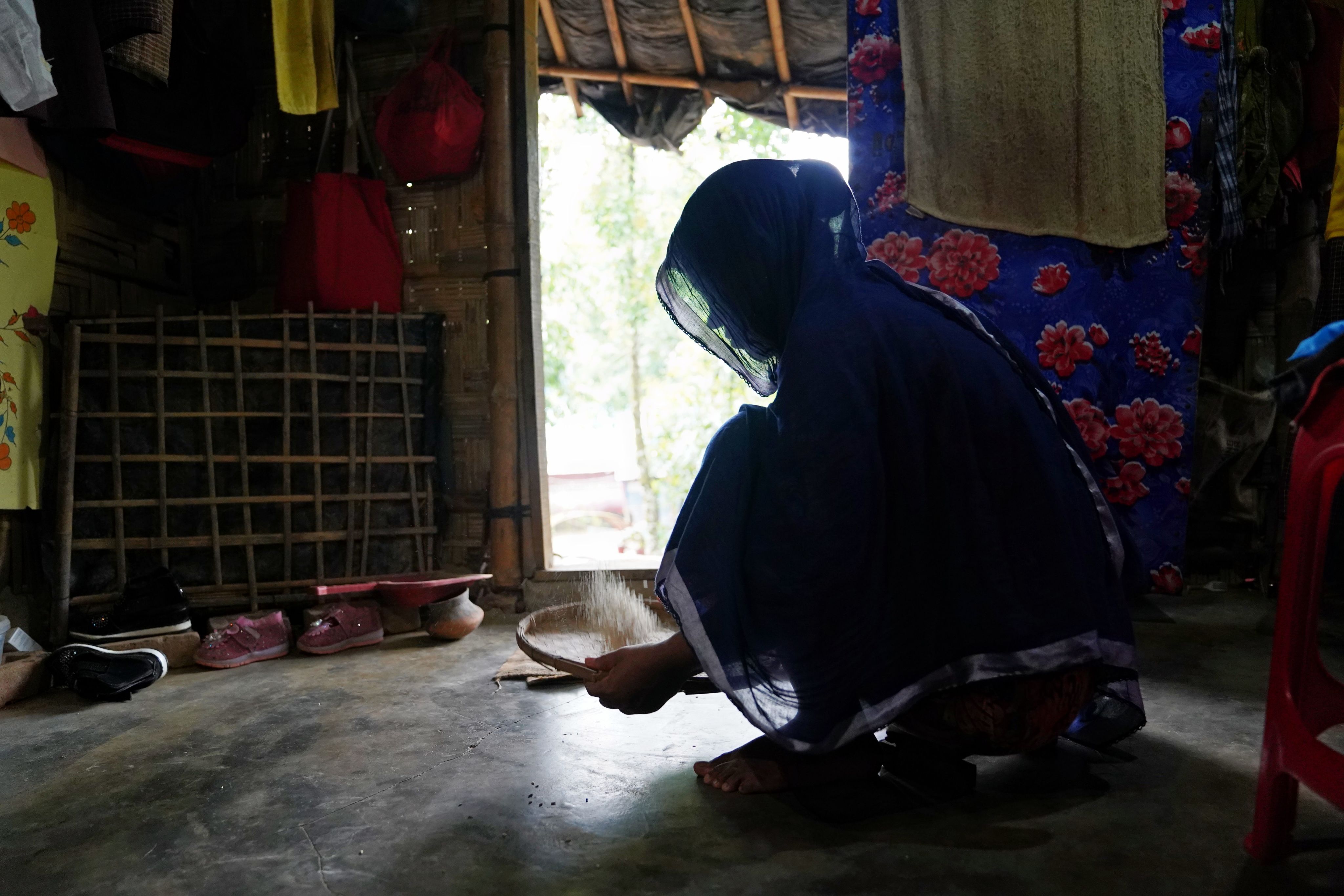
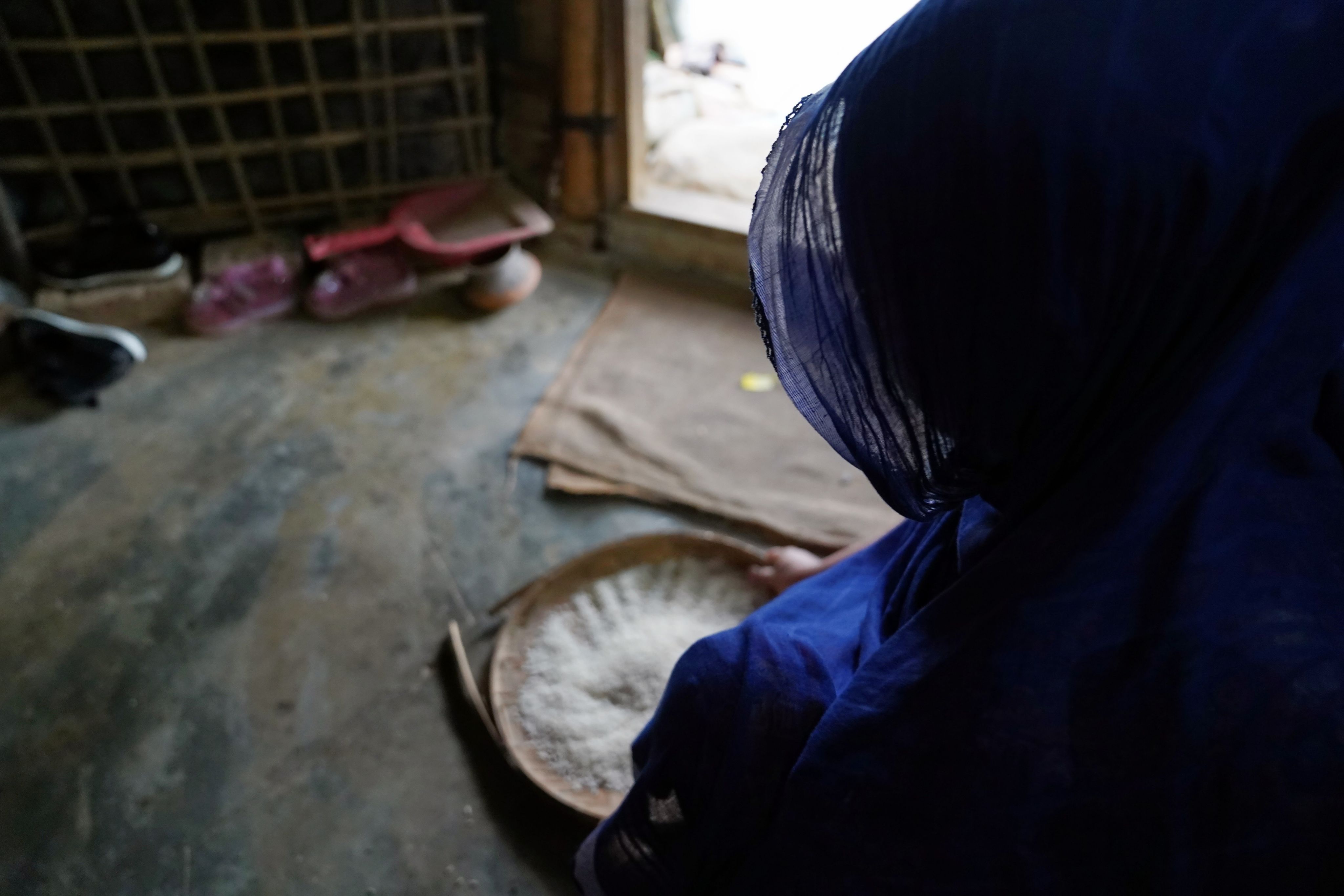
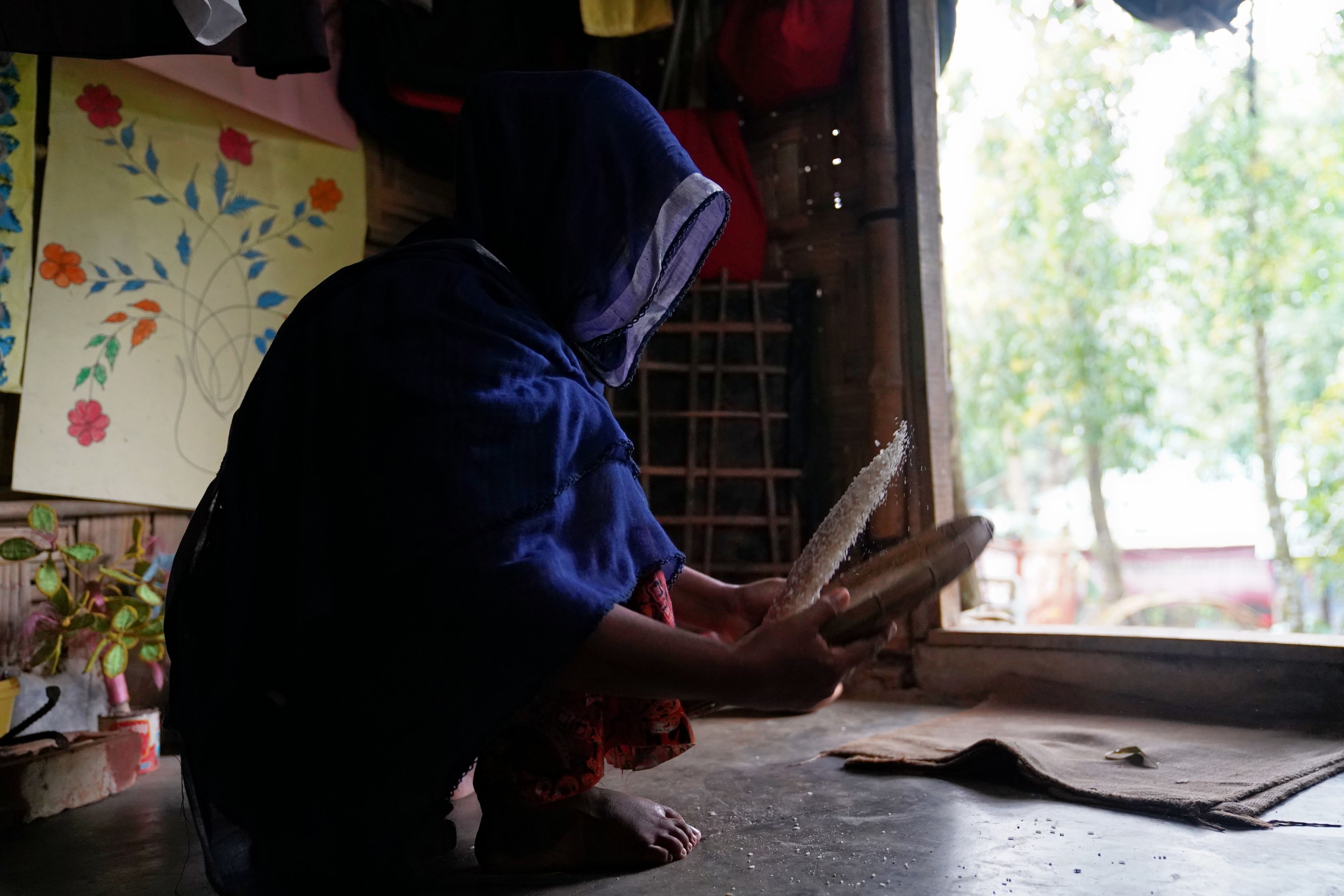
Antora*, Zia*, and Maherun Nesa*'s Stories
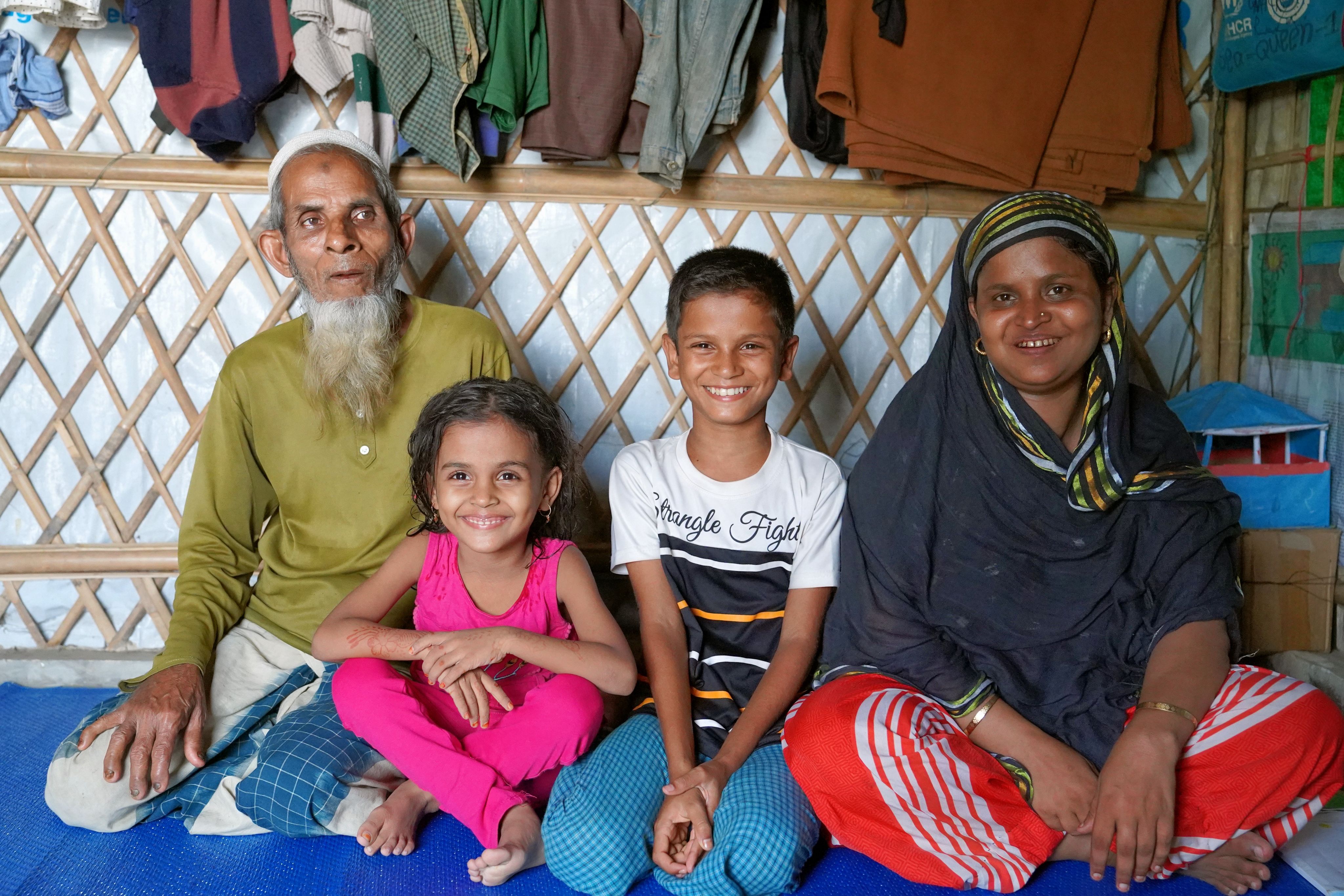
Antora* is five years old. She lives with her four older brothers – including 12-year-old Zia* and 15-year-old Forkan* – as well as her parents in one of the largest refugee camps in the world in Cox’s Bazar in Bangladesh.
Due to recent food ration cuts –from $12.00 USD to $10.00 USD and from $10.00 USD to $8.00 USD – Antora*s family is struggling to afford to feed themselves daily. These USD amounts are per person per month. Due to the recent food ration cuts, Antora*s mother buys two kg of lentils instead of one kg of lentils, three kgs of salt instead of one kg of salt, and four kgs of sugar instead of one kg of sugar. In addition, she no longer buys chicken, fruit, or vegetables aside from spinach and cress.
Instead, Antora*s mother stocks up on rice because the grain is filling and can be eaten plain. On the days when there isn’t enough food for everyone in the family to have more than one meal, the older family members skip eating.
Antora*, 5, helps her mother prepare a meal with their food rations in Cox's Bazar, Bangladesh. Photo: Rubina Hoque Alee / Save the Children
Antora*, 5, helps her mother prepare a meal with their food rations in Cox's Bazar, Bangladesh. Photo: Rubina Hoque Alee / Save the Children
As a result, the family is getting thinner day by day.
Moreover, due to a lack of nutritious food, Antora* fell ill and caught an infection. She was referred to an aid worker in their refugee camp and, eventually, Anotra* was admitted into a nearby healthcare facility for treatment. During her two months after receiving treatment, she underwent an operation for her infection and took nutrition support for being malnourished. The five-year-old girl recovered, but she fell ill again soon after.
Looking forward, Antora*s mother hopes to be able to afford nutritious food like fruits and vegetables for her children. She dreams of them being healthy and strong as adults. In the future, Antora* wants to become a teacher. She hopes to earn enough money to help her mother feed everyone in their family.
Meherun Nesa*, 40, watches her children - Antora*, 5, Zia*, 12, & Forkan*, 15 - eat a rice-based meal in Cox's Bazar, Bangladesh. Photo: Rubina Hoque Alee / Save the Children
Meherun Nesa*, 40, watches her children - Antora*, 5, Zia*, 12, & Forkan*, 15 - eat a rice-based meal in Cox's Bazar, Bangladesh. Photo: Rubina Hoque Alee / Save the Children
Here, Antora*, Zia*, and Maherun Nesa* share their stories in their own words.
A portrait of Antora*, 5, at her house in Cox's Bazar, Bangladesh. Photo: Rubina Hoque Alee / Save the Children
A portrait of Antora*, 5, at her house in Cox's Bazar, Bangladesh. Photo: Rubina Hoque Alee / Save the Children
A portrait of Antora*, 5, at her house in Cox's Bazar, Bangladesh. Photo: Rubina Hoque Alee / Save the Children
A portrait of Antora*, 5, at her house in Cox's Bazar, Bangladesh. Photo: Rubina Hoque Alee / Save the Children
Antora*, 5
I’m five years and six months old. I live with my [mother], [father], and four elder brothers. I eat regularly. I play with my friends. I love to eat my meal with my family. I love studying with my brothers. I study with my brothers’ help. I study every day. And I listen to [my mother and my father]. When I will be grown up, I want to become a teacher. I want to study with my friends and then become [a] teacher. Then, I’ll teach children, earn money, and I’ll give the money to my [mother].
Zia*, 12
Last time I had fruit was three months ago. We can’t have good food anymore. We can only afford chicken once a month.
If our country becomes calm, it’ll be great. If the people who are away from home are able to return and everybody stays like brothers and sisters then the country will be peaceful. And everyone will be able to achieve their dreams.
I want everybody around the world to remain happy and smiling and no one to engage in conflicts. If that is so, it’s good for them and people will be able to stay in their motherland. That’ll be a great welfare for everyone.
I want to become a Hafez [someone who memorizes the Quran] and I’ll live with my parents and my siblings always. I’ll be able to teach others. By teaching, I’ll earn money and I’ll give it to my mother. The way my parents care for me, I’ll take care of them when I grow up. If possible, I’ll help the poor from my earnings.
Maherun Nesa*, 40
When hunger strikes, I don’t see anything else. At least we’re fed even if we eat salt and rice [when] no one’s watching. But what they now give us [isn’t enough] for our seven-member family.
Afterwards, [after the first ration cut], it was 1030 taka [$10.00 USD]. At least we could have some groceries. Then, it became 805 taka [$8.00 USD]. With this amount, we’re getting [less things].
Sometimes, if we have a meal for [the] morning, we don’t have much for [the] evening. In those days, the older [family members] skip their meal and try to feed the younger ones [since] they don’t understand [what’s going on] and since we’re adults, we try to feed them properly.
My daughter was very healthy earlier, [but] slowly she became slender as we can’t feed
[her] good enough food [...] She recovered and got well, but later on, when we couldn’t provide her a balanced diet, she fell ill again.
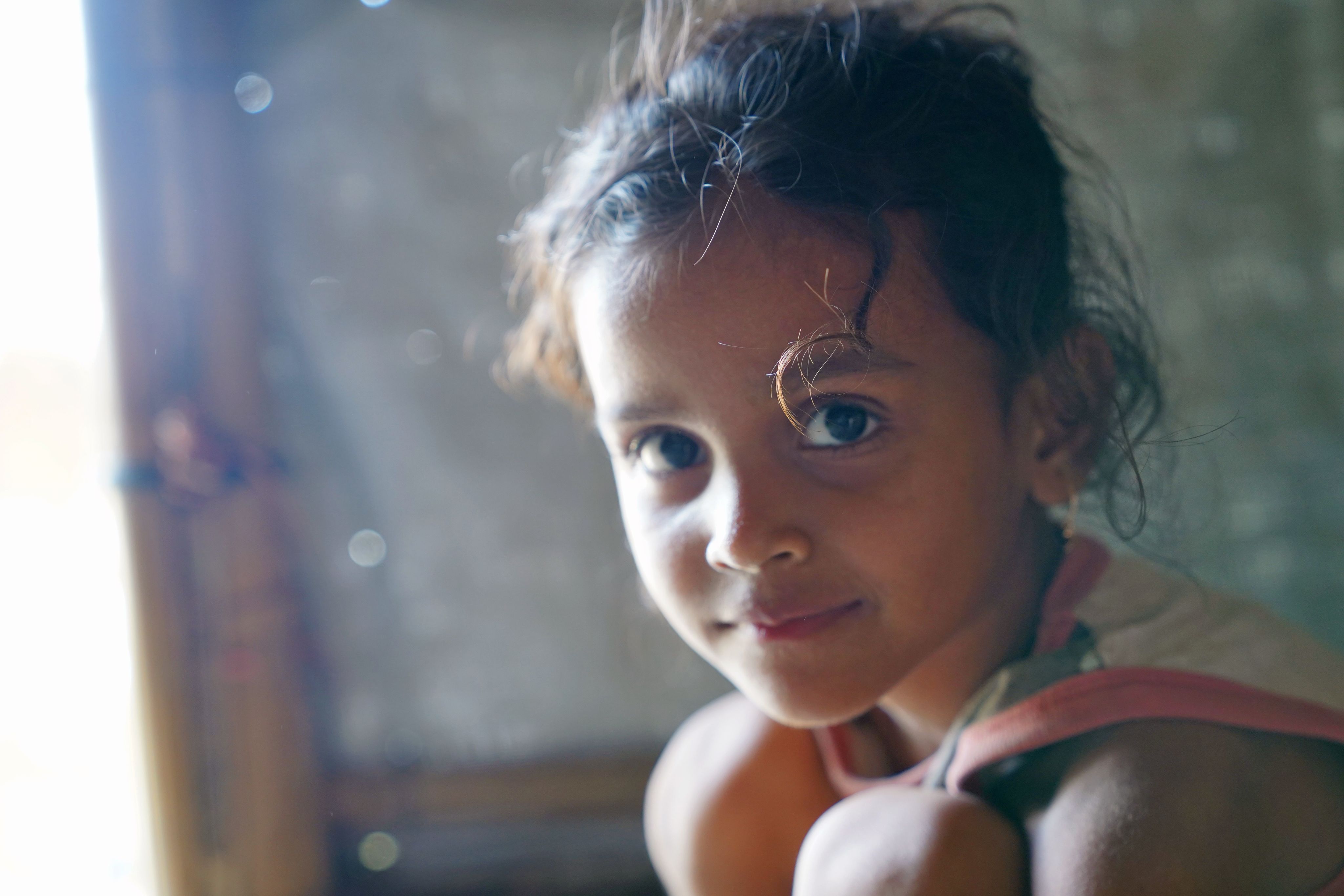
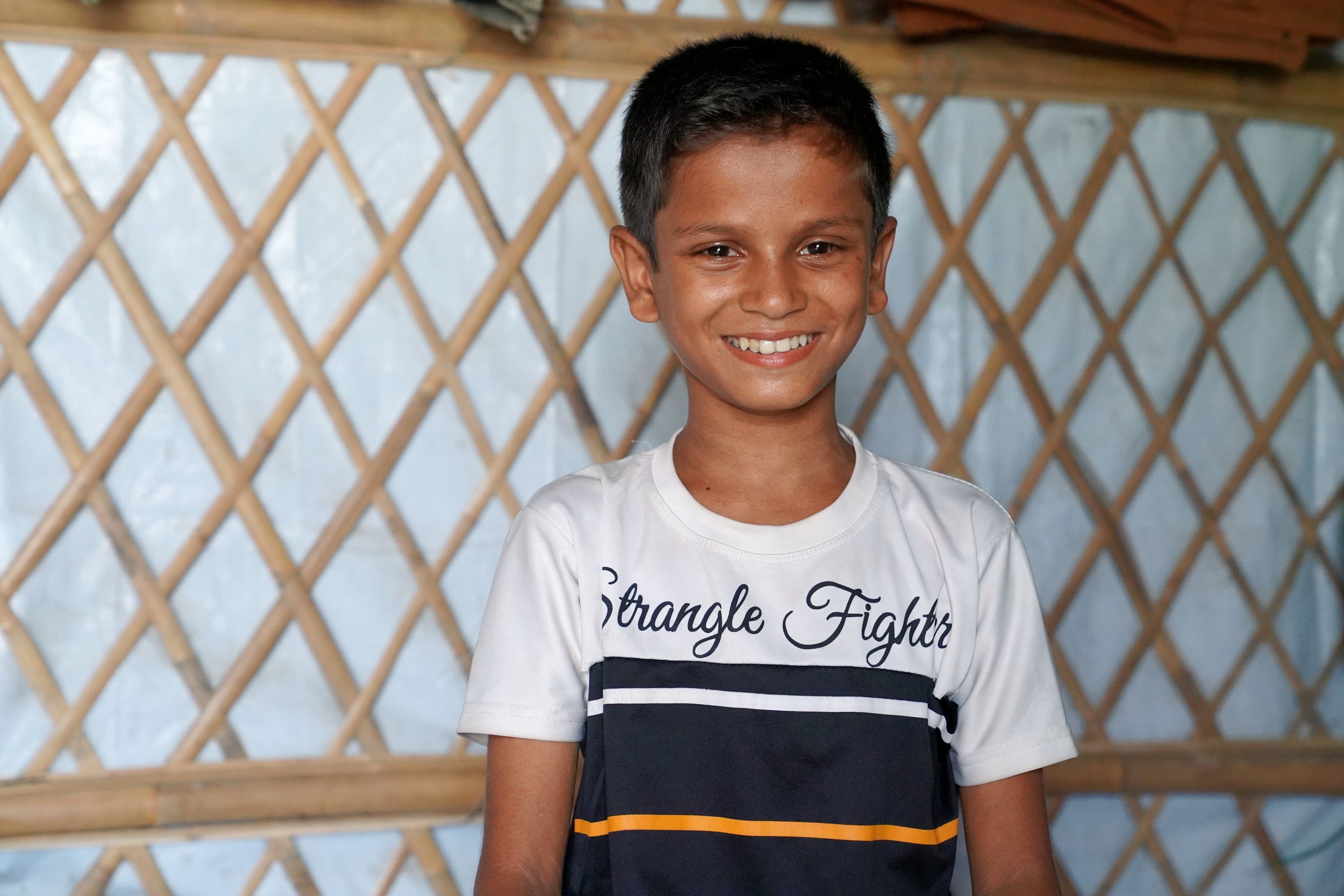
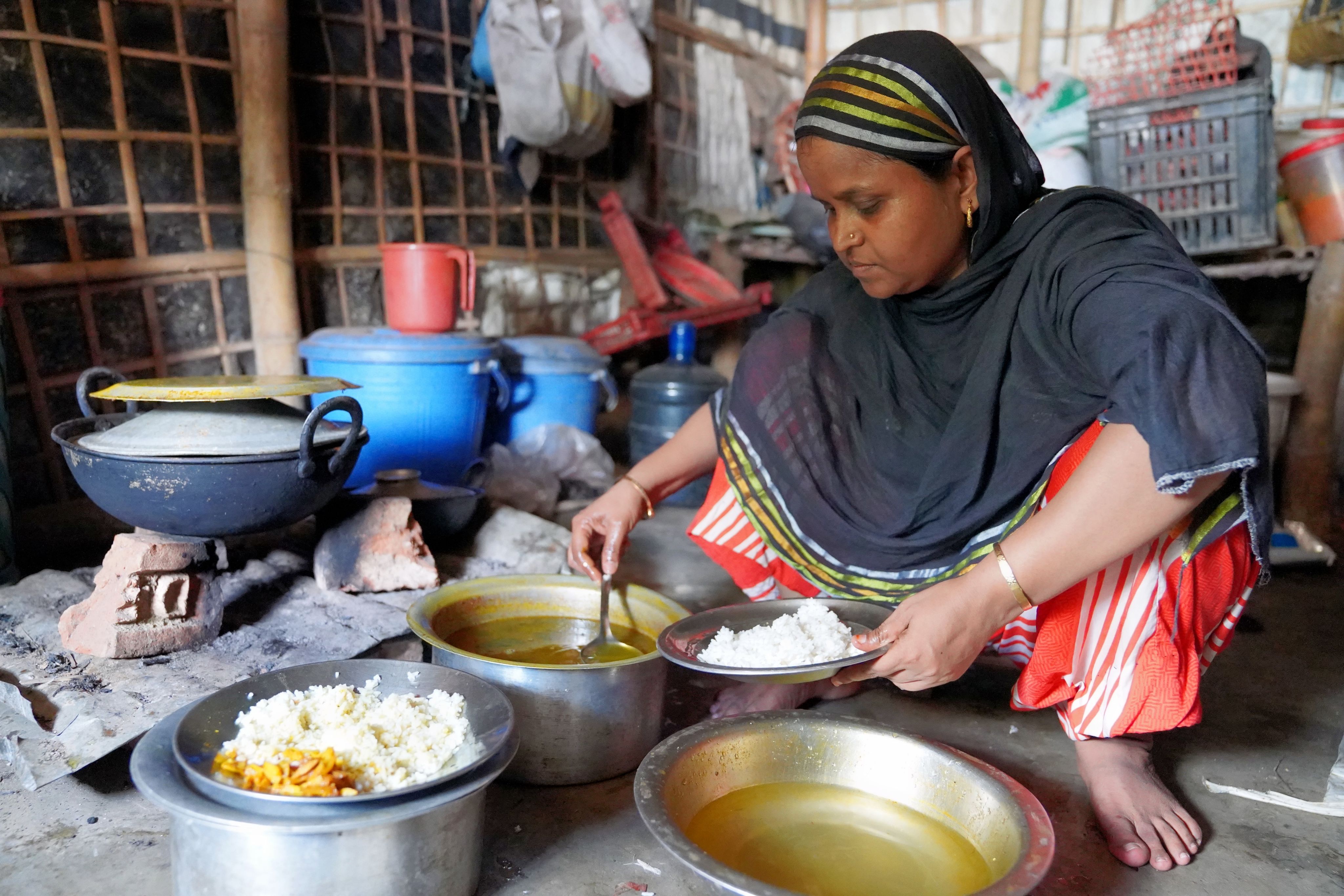
Ayaz*, 15, and his younger siblings walk to a Save the Children supported Learning Centre in Cox's Bazar, Bangladesh. Photo: Saddam Hosen / Save the Children
Ayaz*, 15, and his younger siblings walk to a Save the Children supported Learning Centre in Cox's Bazar, Bangladesh. Photo: Saddam Hosen / Save the Children
What we're doing about it
Save the Children International (SCI) has been working in Cox's Bazar since 2012 and the area office has been operating in seven sectors in the camps since 2017. Maintaining over 200 facilities to ensure smooth service to the community. Due to geographical location, each block has various accessibility challenges. The shelters are in challenging locations like the top of a hill, on the edge of a cliff, and yet others are prone to flooding, having a variety of risks.
With more than 50 years in aid services in Bangladesh, SCI is one of the leading international NGOs in Cox’s Bazar, having reached more than 600,000 Rohingyas and host community members, including more than 477,000 children since the response started.
How we are helping Sultana* and her family
In the refugee camp, Rakib* and Sultana* visit a Child-Friendly Space, which is supported by Save the
Children, on a regular basis. There, Rakib* and Sultana* take part in activities like making crafts and playing games with other children. They attend a Learning Center that’s supported by Save the Children as well.
In addition, their mother – Mahbuba* – volunteers with Save the Children in the refugee camp. She receives monetary compensation for helping out, which she uses to support her family.
How we are helping Ayaz* and his family
Directly in front of the family’s house, Save the Children runs a Multi-Purpose Child and Adolescent Centre (MPCAC). Here, Ayaz* and his siblings attend activities, meetings, and sessions – such as planting trees, taking part in art competitions, and raising awareness about child marriage – alongside other children who live in the refugee camp.
In 2018, Ayaz* began studying at a Learning Centre implemented by Young Power in Social Action (YPSA), which is a Save the Children partner organisation. He completed studying up to Level
Three, which is equivalent to completing a Bangladeshi education up to grade five. Now, Ayaz* is waiting / hoping to enter the scaled-up Myanmar Curriculum (MC) system that was implemented in Cox’s Bazar in June 2022. This new MC system is equivalent to completing a Bangladeshi education up to grade 10.
In addition, the family lives nearby a Health Post that’s supported by Save the Children. This is where they receive medical support if needed.
How we are helping Antora* and her family
Anasullah* and Meherun Nesa* took their malnourished daughter, Antora*, to a Primary Health Care Centre and Child Protection team within Save the Children at their refugee camp. The young girl was referred to the nutrition focal point for treatment.
How you can help
Now is not the time to abandon Rohingya children and families. Please donate to our Children´s Emergency Fund to help children and families like Mahbuba*, Sultana*, Rakib*, Ayaz*, Farijan*, and Anisa* today.
Your donation to our Children's Emergency Fund will allow our response teams to react quickly to emergencies around the world.

